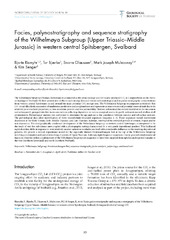| dc.contributor.author | Rismyhr, Bjarte | |
| dc.contributor.author | Bjærke, Tor | |
| dc.contributor.author | Olaussen, Snorre | |
| dc.contributor.author | Mulrooney, Mark Joseph | |
| dc.contributor.author | Senger, Kim | |
| dc.date.accessioned | 2019-05-29T08:45:06Z | |
| dc.date.available | 2019-05-29T08:45:06Z | |
| dc.date.issued | 2019 | |
| dc.Published | Rismyhr B, Bjærke T, Olaussen S, Mulrooney MJ, Senger K. Facies, palynostratigraphy and sequence stratigraphy of the Wilhelmøya Subgroup (Upper Triassic–Middle Jurassic) in western central Spitsbergen, Svalbard. Norsk Geologisk Tidsskrift. 2019;99(4):35-64 | eng |
| dc.identifier.issn | 0029-196X | en_US |
| dc.identifier.issn | 1502-5322 | en_US |
| dc.identifier.uri | https://hdl.handle.net/1956/19796 | |
| dc.description.abstract | The Wilhelmøya Subgroup (Norian–Bathonian) is considered as the prime storage unit for locally produced CO2 in Longyearbyen on the Arctic archipelago of Svalbard. We here present new drillcore and outcrop data and refined sedimentological and sequence-stratigraphic interpretations from western central Spitsbergen in and around the main potential CO2-storage area. The Wilhelmøya Subgroup encompasses a relatively thin (15–24 m) siliciclastic succession of mudstones, sandstones and conglomerates and represents an unconventional potential reservoir unit due to its relatively poor reservoir properties, i.e., low-moderate porosity and low permeability. Thirteen sedimentary facies were identified in the succession and subsequently grouped into five facies associations, reflecting deposition in various marginal marine to partly sediment-starved, shallow shelf environments. Palynological analysis was performed to determine the age and aid in the correlation between outcrop and subsurface sections. The palynological data allow identification of three unconformity-bounded sequences (sequence 1–3). These sequences record intermittent deposition in the Early Norian, Early–Middle Toarcian, and Late Toarcian–Aalenian, interrupted by extended periods of erosion, bypass and/or non-deposition. The stratigraphically condensed development of the Wilhelmøya Subgroup in western central Spitsbergen is interpreted to be the result of very low subsidence rates coupled with a physiographic setting characterised by a very gentle depositional gradient. This facilitated rapid shoreline shifts in response to even relatively modest variations in relative sea level with considerable influence on the resulting depositional patterns. We present a revised depositional model for the regionally distinct Brentskardhaugen Bed at the top of the Wilhelmøya Subgroup involving condensation and partial reworking of a series of Upper Toarcian–Aalenian, high-frequency sequences. Coarse-grained extraformational fractions observed within conglomerates of the Wilhelmøya Subgroup are suggested to have been supplied from uplifted and exposed margins to the west (northern Greenland) and north (northern Svalbard). | en_US |
| dc.language.iso | eng | eng |
| dc.publisher | Geological Society of Norway | en_US |
| dc.rights | Attribution CC BY | eng |
| dc.rights.uri | http://creativecommons.org/licenses/by/4.0 | eng |
| dc.subject | Wilhelmøya Subgroup | eng |
| dc.subject | Brentskardhaugen Bed | eng |
| dc.subject | Sequence stratigraphy | eng |
| dc.subject | Facies analysis | eng |
| dc.subject | Palynology | eng |
| dc.subject | condensed unit | eng |
| dc.title | Facies, palynostratigraphy and sequence stratigraphy of the Wilhelmøya Subgroup (Upper Triassic–Middle Jurassic) in western central Spitsbergen, Svalbard | en_US |
| dc.type | Peer reviewed | |
| dc.type | Journal article | |
| dc.date.updated | 2019-01-17T13:29:04Z | |
| dc.description.version | publishedVersion | en_US |
| dc.rights.holder | Copyright 2018 The Author(s) | en_US |
| dc.identifier.doi | https://doi.org/10.17850/njg001 | |
| dc.identifier.cristin | 1648319 | |
| dc.source.journal | Norsk Geologisk Tidsskrift | |

